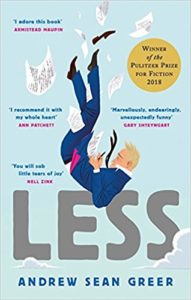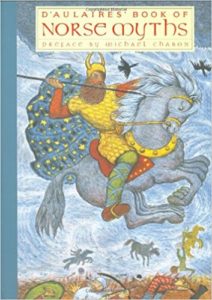“Less” by Andrew Sean Greer
 Arthur Less has been here for three days; he is in New York to interview famous science fiction author H.H.H. Mandern onstage to celebrate the launch of of H. H. H. Mandern’s new novel; in it, he revives his wildly popular Holmesian robot, Peabody. In the world of books, this is front-page news, and a great deal of money is jangling behind the scenes. Money in the voice that called Less out of the blue and asked if he was familiar with the work of H.H.H. Mandern, and if he might be available for an interview. Money in the messages from the publicist instructing Less what questions were absolutely off the table for H.H.H. Mandern (his wife, his daughter, his poorly reviewed poetry collection). Money in the choice of venue, the advertisements plastered all over the Village. Money in the inflatable Peabody battling the wind outside the theater. Money even in the hotel Arthur has been placed in, where he was shown a pile of “complimentary” apples he can feel free to take anytime, day or night, you’re welcome. In a world where most people read one book and that this night will be the glorious kickoff. And they are depending on Arthur Less.
Arthur Less has been here for three days; he is in New York to interview famous science fiction author H.H.H. Mandern onstage to celebrate the launch of of H. H. H. Mandern’s new novel; in it, he revives his wildly popular Holmesian robot, Peabody. In the world of books, this is front-page news, and a great deal of money is jangling behind the scenes. Money in the voice that called Less out of the blue and asked if he was familiar with the work of H.H.H. Mandern, and if he might be available for an interview. Money in the messages from the publicist instructing Less what questions were absolutely off the table for H.H.H. Mandern (his wife, his daughter, his poorly reviewed poetry collection). Money in the choice of venue, the advertisements plastered all over the Village. Money in the inflatable Peabody battling the wind outside the theater. Money even in the hotel Arthur has been placed in, where he was shown a pile of “complimentary” apples he can feel free to take anytime, day or night, you’re welcome. In a world where most people read one book and that this night will be the glorious kickoff. And they are depending on Arthur Less.
2018 Pulitzer-prize winning novel Less by Andrew Sean Greer. It is a comedic book about Arthur Less, a white male gay writer, about to hit fifty, who to avoid attending the wedding of his ex-lover decides to accept all the “literary” invitations in his inbox to attend around the world. A surprising win at this year’s Pulitzer award, Less is a delightful novel for its romp through the literary space around the world, attending book launches, panel discussions, literary festivals, workshop retreats, creative writing classes etc. Wait for the superb end!
Andrew Sean Greer was in Italy when he heard he had won the Pulitzer Prize. To confirm the win he called his friend, novelist and former winner of the Pulitzer Prize, Michael Chabon. This is what he posted on Twitter.
OMG I won the Pulitzer Prize? Nobody is more surprised than I am! I was working at my job here Italy and had just persuaded a dog to let me put her into polka dot pajamas (not my dog) when I heard the news. I didn’t believe it. So I called my friend Michael Chabon, who screamed
— Andrew Sean Greer (@agreer) April 17, 2018
I asked if it was true, and he said yes! And I asked what do I do now? And he said Andy, now you write whatever you want to. And then I went and drank a lot of red wine. I hope somebody put some money on me because they have surely made a fortune now. Let’s be honest:
— Andrew Sean Greer (@agreer) April 17, 2018
It’s been a tough year, and a tough time in the world. And perhaps it is foolish to believe, but I do believe, despite all this, in the possibility of joy.
(Can you tell I'm still in shock?)
— Andrew Sean Greer (@agreer) April 17, 2018
it was an incredible year for books, and writers like Jesmyn Ward, Celeste Ng, Min Jin Lee, George Saunders, Elif Batuman and Hernan Diaz all deserve mention here, as well as dozens of other amazing books (you should really follow @pronounced_ing ). As for my book,
— Andrew Sean Greer (@agreer) April 17, 2018
In this wonderful interview with Isaac Fitzgerald on AM to DM, Buzzfeed News, Andrew Sean Greer discuss writing of this comedic novel which also happens to set a new benchmark for gay art/queer narratives. Greer says that at first Less was a sad and serious book but taking pity on the character he rewrote it. He admits that events and places the character visits are “totally pilfered from my life, in a kleptomaniac way”.
Full interview: @agreer joins #AM2DM to discuss his Pulitzer Prize-winning novel "Less" pic.twitter.com/AAxXMkS3VP
— AM to DM by BuzzFeed News (@AM2DM) June 7, 2018
Less is going to be a book that will be exceedingly difficult to forget. It will stick for years to come. There is something about it that is impossible to shed. It is there forever.
To buy online
Andrew Sean Greer Less Abacus, an imprint of Little, Brown Book Group, London, 2018. Pb. pp. 265. Rs. 499
25 June 2018

